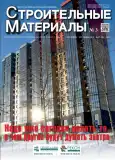On the Mechanism of Destruction and Oxidation of Starch for the Production of Plasterboard Sheets (PBS)
- Authors: Araslankin S.V.1, Shchankin M.V.1, Buryanov A.F.2, Nipruk O.V.3
-
Affiliations:
- «Exponenta» LLC
- National Research Moscow State University of Civil Engineering
- Lobachevsky State University of Nizhny Novgorod (National Research University)
- Issue: No 3 (2024)
- Pages: 43-47
- Section: Gyrsum bullding materials
- URL: https://journals.eco-vector.com/0585-430X/article/view/635755
- DOI: https://doi.org/10.31659/0585-430X-2024-822-3-43-47
- ID: 635755
Cite item
Abstract
The technological process of PBS production requires careful control of the phase composition of the gypsum binder used, as well as compliance with the drying modes of the sheets. This is necessary in order to ensure the adhesion of the gypsum core to the cardboard and, as a result, to give the sheets the required mechanical and physical properties. The use of various kinds of modified starches in the production technology of PBS makes it possible to achieve the required adhesion with fluctuations in the phase composition of the binder and deviations in the drying mode of products. Considering this, it becomes obvious that the characteristics of modified starches have a significant effect on the quality of PBS. The study of existing standards regulating the quality indicators of starch derivatives showed the absence of parameters reflecting the effectiveness of their use in the production technology of PBS. In this paper, the structural features of the most widely used types of modified starch are considered. The paper summarizes information about the mechanism of adhesion of the gypsum core to cardboard, the factors influencing this process, the mechanisms of starch destruction and oxidation, and also offers a list of quality indicators of starch derivatives and the requirements for them. It is shown that the effectiveness of the use of modified starches in the production of PBS is achieved by regulating the direction and depth of the processes of destruction and oxidation.
Full Text
About the authors
S. V. Araslankin
«Exponenta» LLC
Author for correspondence.
Email: ceo@sci-exp.ru
CEO
Russian Federation, 26 A, Stanislavskogo Street, Ruzayevka, 431448M. V. Shchankin
«Exponenta» LLC
Email: lab@sci-exp.ru
Candidate of Science (Biology), Senior Scientist
Russian Federation, 26 A, Stanislavskogo Street, Ruzayevka, 431448A. F. Buryanov
National Research Moscow State University of Civil Engineering
Email: rga-service@mail.ru
Doctor of Sciences (Engineering)
Russian Federation, 26, Yaroslavskoe Highway, Moscow, 129337O. V. Nipruk
Lobachevsky State University of Nizhny Novgorod (National Research University)
Email: nipruk@chem.unn.ru
Doctor of Sciences (Chemistry)
Russian Federation, 23, Gagarina Avenue, Nizhny Novgorod, 603022References
- Jiang T., Duan Q., Zhu J. et al. Starch-based biodegradable materials: challenges and opportunities. Advanced Industrial and Engineering Polymer Research. 2020. Vol. 3. No. 1, pp. 8–18. https://doi.org/10.1016/j.aiepr.2019.11.003
- Toraya-Aviles R., Segura-Campos M., Chel-Guerrero L., Betancur-Ancona D. Effects of pyroconversion and enzymatic hydrolysis on indigestible starch content and physicochemical properties of cassava (Manihot esculenta) starch. Starch. 2016. Vol. 68, pp. 1–9. https://doi.org/10.1002/star.201600267
- Lewicka K., Siemion P., Kurcok P. Chemical modifications of starch: microwave effect. International Journal of Polymer Science. 2015. Vol. 9, pp. 1–10. https://doi.org/10.1155/2015/867697
- Le Thanh-Blicharz J., Błaszczak W., Szwengiel A. et al. Molecular and supermolecular structure of commercial pyrodextrins. Journal of Food Science. 2016. Vol. 81. No. 9, pp. 135–142. https://doi.org/10.1111/1750-3841.13401
- Sun Z., Kang J., Shi Y.C. Changes in molecular size and shape of waxy maize starch during dextrinization. Food Chemistry. 2021. Vol. 348. 128983. https://doi.org/10.1016/j.foodchem.2020.128983
- Забежинский Я.Л., Белов А.Д. О механизме сцепления гипса с картоном при производстве сухой гипсовой штукатурки // Механизм твердения вяжущих и гипсовые материалы: Сборник трудов. 1957. № 1. С. 90–97.
- Zabezhinsky Ya.L., Belov A.D. About the mechanism of adhesion of gypsum to cardboard in the production of dry gypsum plaster. Hardening mechanism of binders and gypsum materials. Collection of works. 1957. No. 1, pp. 90–97 (In Russian).
- Maulana M.I., Rahandi Lubis M.A., Febrianto F. et al. Environmentally friendly starch-based adhesives for bonding high-performance wood composites: a review. Forests. 2022. Vol. 13. No. 10. 1614. https://doi.org/10.3390/f13101614
- Li H., Ji J., Yang L. et al. Structural and physicochemical property changes during pyroconversion of native maize starch. Carbohydrate Polymers. 2020. Vol. 245. 116560. https://doi.org/10.1016/j.carbpol.2020.116560
- Weil W., Weil R.C., Keawsompong S. et al. Pyrodextrins from waxy and normal tapioca starches: Molecular structure and in vitro digestibility. Carbohydrate Polymers. 2021. Vol. 252. 117140. https://doi.org/10.1016/j.carbpol.2020.117140
- Ye S.J., Baik M.Y. Characteristics of physically modified starches. Food Science and Biotechnology. 2023. Vol. 32. No. 7, pp. 875–883. https://doi.org/10.1007/s10068-023-01284-3
- Lei Su, Fengjuan Xiang, Renbing Qin, Zhanxiang Fang. Study on mechanism of starch phase transtion in wheat with different moisture content. Food Science and Technology (Campinas). 2022. Vol. 45. No. 1, pp. 1–13. https://doi.org/10.1590/fst.106521
- Nawaz H., Waheed R., Nawaz M., Shahwar D. Physical and chemical modifications in starch structure and reactivity. Chemical Properties of Starch. 2020, рр. 1–21. https://doi.org/10.5772/intechopen.88870
- Bai Y., Shi Y.C. Chemical structures in pyrodextrin determined by nuclear magnetic resonance spectroscopy. Carbohydrate Polymers. 2016. Vol. 151, pp. 426–433. https://doi.org/10.1016/j.carbpol.2016.05.058
- Kwon S., Chung K.M., Shin S.I., Moon T.W. Contents of indigestible fraction, water solubility, and color of pyrodextrins made from waxy sorghum starch. Cereal Chemistry. 2005. Vol. 82. No. 1, pp. 101–104. https://doi.org/10.1094/CC-82-0101
- Dimri S., Aditi Bist Y., Singh S. Oxidation of Starch. In: Sharanagat V.S., Saxena D.C., Kumar K., Kumar Y. (eds) Starch: Advances in Modifications, Technologies and Applications. Springer, Cham. https://doi.org/10.1007/978-3-031-35843-2_3
Supplementary files










